AF 2: Australian Fire Research Report: Health Impacts of Fires
VerifiedAdded on 2022/08/16
|8
|1821
|17
Report
AI Summary
This report examines the devastating impact of Australian wildfires on public health. It details the widespread destruction, including the loss of life, homes, and the environment. The report explores the immediate and long-term health consequences of fire exposure, particularly the effects of smoke inhalation. It highlights the respiratory and cardiovascular issues caused by PM2.5 particles and other toxic gases, as well as the mental health challenges, such as stress, anxiety, and PTSD, experienced by those affected. The report also discusses the vulnerability of different populations, including the elderly, children, and firefighters, and provides insights into the broader implications of these fires, including the release of significant amounts of CO2 into the atmosphere. The report concludes by emphasizing the need for public health interventions and support for affected communities.

Running Head: AF 0
Australian Fire
Research report
FEBRUARY 4, 2020
Australian Fire
Research report
FEBRUARY 4, 2020
Paraphrase This Document
Need a fresh take? Get an instant paraphrase of this document with our AI Paraphraser
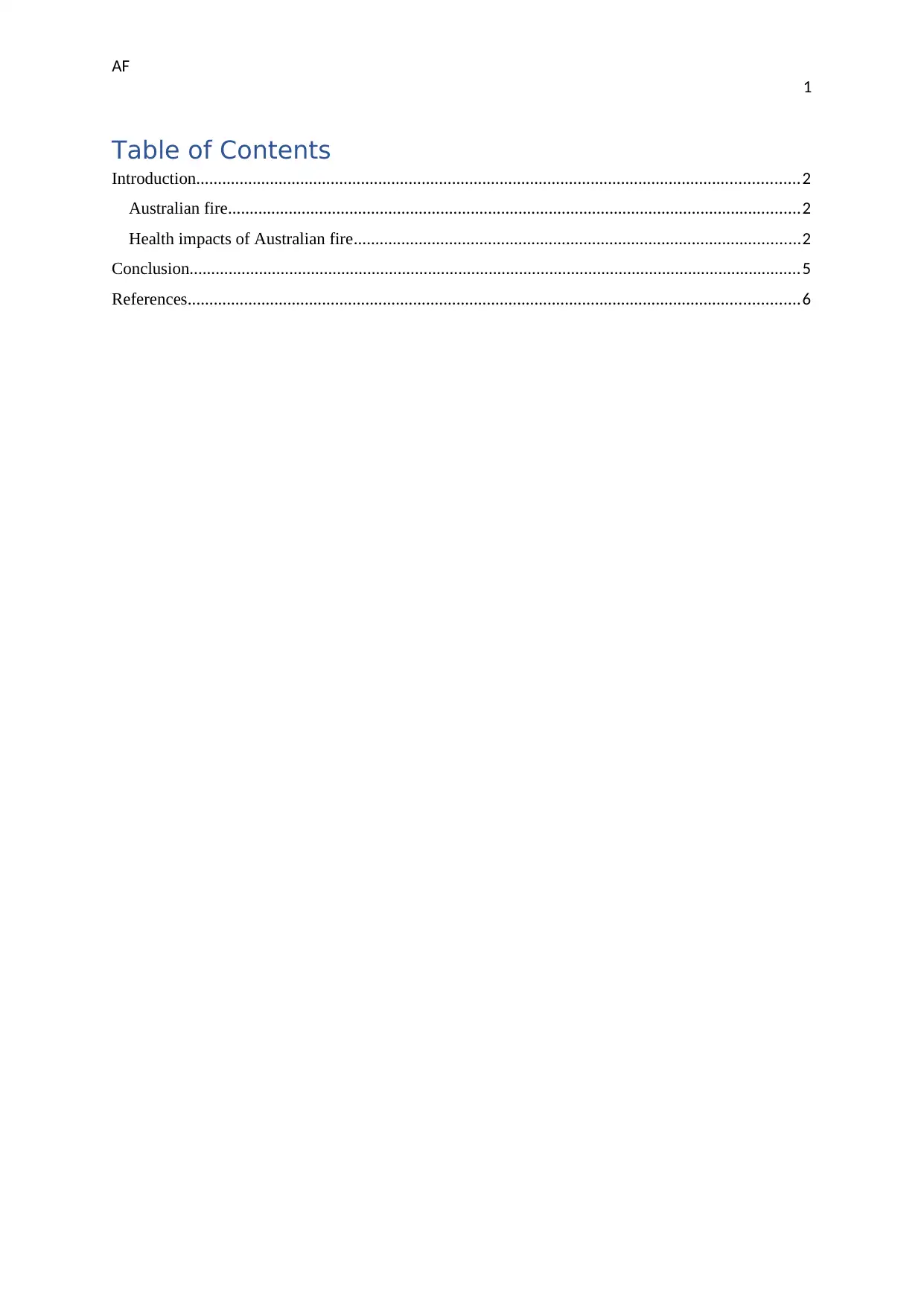
AF
1
Table of Contents
Introduction...........................................................................................................................................2
Australian fire....................................................................................................................................2
Health impacts of Australian fire.......................................................................................................2
Conclusion.............................................................................................................................................5
References.............................................................................................................................................6
1
Table of Contents
Introduction...........................................................................................................................................2
Australian fire....................................................................................................................................2
Health impacts of Australian fire.......................................................................................................2
Conclusion.............................................................................................................................................5
References.............................................................................................................................................6
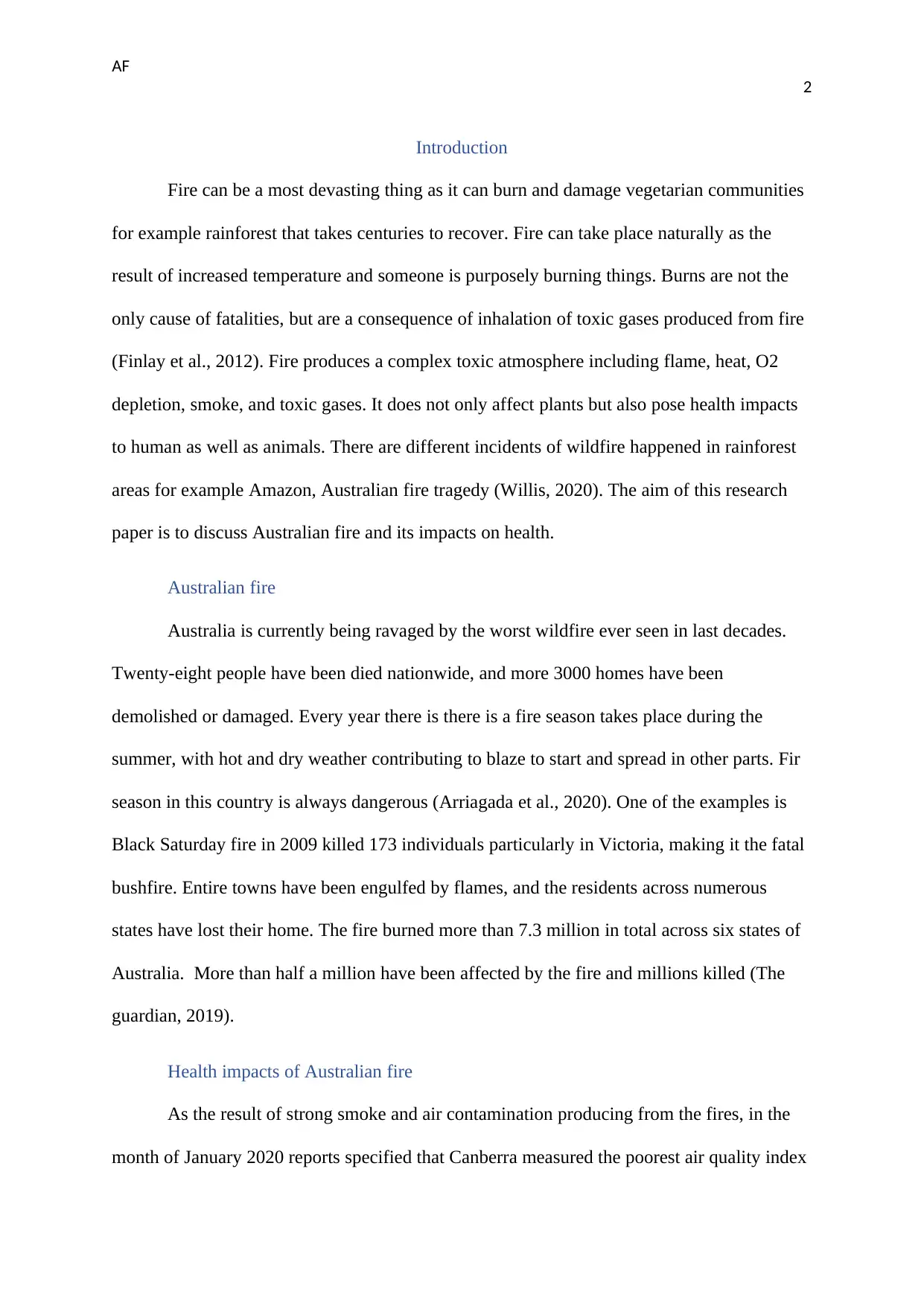
AF
2
Introduction
Fire can be a most devasting thing as it can burn and damage vegetarian communities
for example rainforest that takes centuries to recover. Fire can take place naturally as the
result of increased temperature and someone is purposely burning things. Burns are not the
only cause of fatalities, but are a consequence of inhalation of toxic gases produced from fire
(Finlay et al., 2012). Fire produces a complex toxic atmosphere including flame, heat, O2
depletion, smoke, and toxic gases. It does not only affect plants but also pose health impacts
to human as well as animals. There are different incidents of wildfire happened in rainforest
areas for example Amazon, Australian fire tragedy (Willis, 2020). The aim of this research
paper is to discuss Australian fire and its impacts on health.
Australian fire
Australia is currently being ravaged by the worst wildfire ever seen in last decades.
Twenty-eight people have been died nationwide, and more 3000 homes have been
demolished or damaged. Every year there is there is a fire season takes place during the
summer, with hot and dry weather contributing to blaze to start and spread in other parts. Fir
season in this country is always dangerous (Arriagada et al., 2020). One of the examples is
Black Saturday fire in 2009 killed 173 individuals particularly in Victoria, making it the fatal
bushfire. Entire towns have been engulfed by flames, and the residents across numerous
states have lost their home. The fire burned more than 7.3 million in total across six states of
Australia. More than half a million have been affected by the fire and millions killed (The
guardian, 2019).
Health impacts of Australian fire
As the result of strong smoke and air contamination producing from the fires, in the
month of January 2020 reports specified that Canberra measured the poorest air quality index
2
Introduction
Fire can be a most devasting thing as it can burn and damage vegetarian communities
for example rainforest that takes centuries to recover. Fire can take place naturally as the
result of increased temperature and someone is purposely burning things. Burns are not the
only cause of fatalities, but are a consequence of inhalation of toxic gases produced from fire
(Finlay et al., 2012). Fire produces a complex toxic atmosphere including flame, heat, O2
depletion, smoke, and toxic gases. It does not only affect plants but also pose health impacts
to human as well as animals. There are different incidents of wildfire happened in rainforest
areas for example Amazon, Australian fire tragedy (Willis, 2020). The aim of this research
paper is to discuss Australian fire and its impacts on health.
Australian fire
Australia is currently being ravaged by the worst wildfire ever seen in last decades.
Twenty-eight people have been died nationwide, and more 3000 homes have been
demolished or damaged. Every year there is there is a fire season takes place during the
summer, with hot and dry weather contributing to blaze to start and spread in other parts. Fir
season in this country is always dangerous (Arriagada et al., 2020). One of the examples is
Black Saturday fire in 2009 killed 173 individuals particularly in Victoria, making it the fatal
bushfire. Entire towns have been engulfed by flames, and the residents across numerous
states have lost their home. The fire burned more than 7.3 million in total across six states of
Australia. More than half a million have been affected by the fire and millions killed (The
guardian, 2019).
Health impacts of Australian fire
As the result of strong smoke and air contamination producing from the fires, in the
month of January 2020 reports specified that Canberra measured the poorest air quality index
⊘ This is a preview!⊘
Do you want full access?
Subscribe today to unlock all pages.

Trusted by 1+ million students worldwide
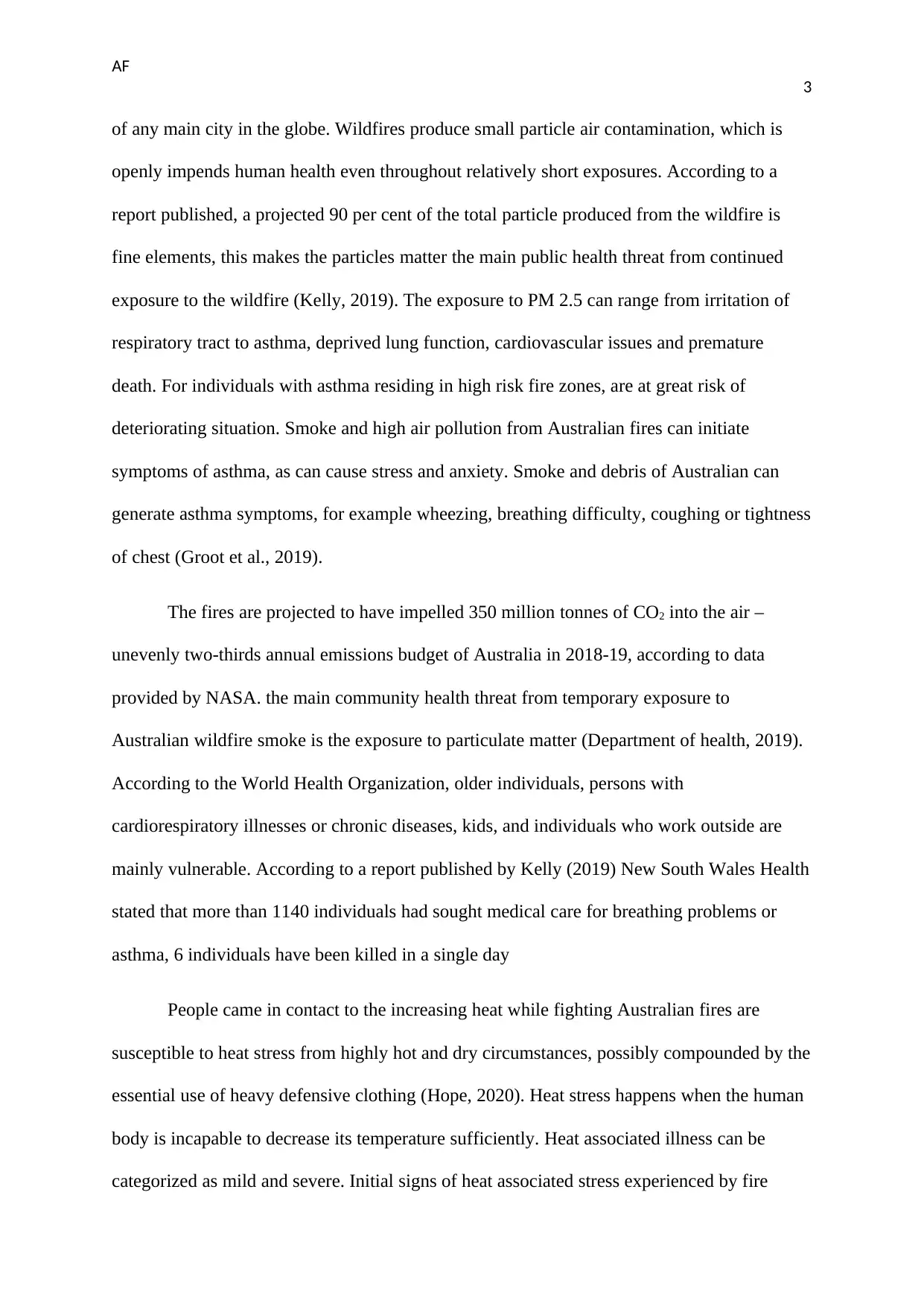
AF
3
of any main city in the globe. Wildfires produce small particle air contamination, which is
openly impends human health even throughout relatively short exposures. According to a
report published, a projected 90 per cent of the total particle produced from the wildfire is
fine elements, this makes the particles matter the main public health threat from continued
exposure to the wildfire (Kelly, 2019). The exposure to PM 2.5 can range from irritation of
respiratory tract to asthma, deprived lung function, cardiovascular issues and premature
death. For individuals with asthma residing in high risk fire zones, are at great risk of
deteriorating situation. Smoke and high air pollution from Australian fires can initiate
symptoms of asthma, as can cause stress and anxiety. Smoke and debris of Australian can
generate asthma symptoms, for example wheezing, breathing difficulty, coughing or tightness
of chest (Groot et al., 2019).
The fires are projected to have impelled 350 million tonnes of CO2 into the air –
unevenly two-thirds annual emissions budget of Australia in 2018-19, according to data
provided by NASA. the main community health threat from temporary exposure to
Australian wildfire smoke is the exposure to particulate matter (Department of health, 2019).
According to the World Health Organization, older individuals, persons with
cardiorespiratory illnesses or chronic diseases, kids, and individuals who work outside are
mainly vulnerable. According to a report published by Kelly (2019) New South Wales Health
stated that more than 1140 individuals had sought medical care for breathing problems or
asthma, 6 individuals have been killed in a single day
People came in contact to the increasing heat while fighting Australian fires are
susceptible to heat stress from highly hot and dry circumstances, possibly compounded by the
essential use of heavy defensive clothing (Hope, 2020). Heat stress happens when the human
body is incapable to decrease its temperature sufficiently. Heat associated illness can be
categorized as mild and severe. Initial signs of heat associated stress experienced by fire
3
of any main city in the globe. Wildfires produce small particle air contamination, which is
openly impends human health even throughout relatively short exposures. According to a
report published, a projected 90 per cent of the total particle produced from the wildfire is
fine elements, this makes the particles matter the main public health threat from continued
exposure to the wildfire (Kelly, 2019). The exposure to PM 2.5 can range from irritation of
respiratory tract to asthma, deprived lung function, cardiovascular issues and premature
death. For individuals with asthma residing in high risk fire zones, are at great risk of
deteriorating situation. Smoke and high air pollution from Australian fires can initiate
symptoms of asthma, as can cause stress and anxiety. Smoke and debris of Australian can
generate asthma symptoms, for example wheezing, breathing difficulty, coughing or tightness
of chest (Groot et al., 2019).
The fires are projected to have impelled 350 million tonnes of CO2 into the air –
unevenly two-thirds annual emissions budget of Australia in 2018-19, according to data
provided by NASA. the main community health threat from temporary exposure to
Australian wildfire smoke is the exposure to particulate matter (Department of health, 2019).
According to the World Health Organization, older individuals, persons with
cardiorespiratory illnesses or chronic diseases, kids, and individuals who work outside are
mainly vulnerable. According to a report published by Kelly (2019) New South Wales Health
stated that more than 1140 individuals had sought medical care for breathing problems or
asthma, 6 individuals have been killed in a single day
People came in contact to the increasing heat while fighting Australian fires are
susceptible to heat stress from highly hot and dry circumstances, possibly compounded by the
essential use of heavy defensive clothing (Hope, 2020). Heat stress happens when the human
body is incapable to decrease its temperature sufficiently. Heat associated illness can be
categorized as mild and severe. Initial signs of heat associated stress experienced by fire
Paraphrase This Document
Need a fresh take? Get an instant paraphrase of this document with our AI Paraphraser
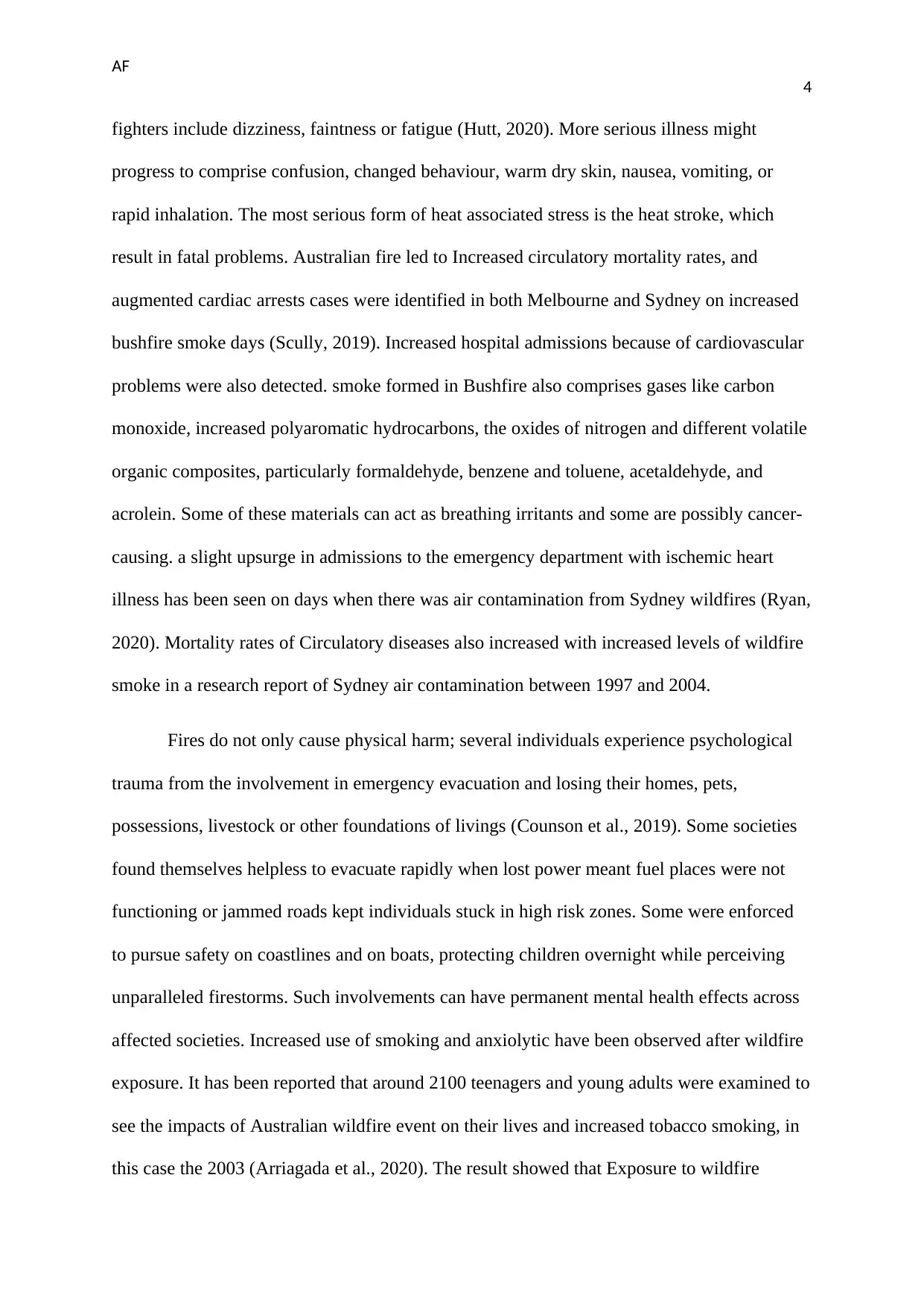
AF
4
fighters include dizziness, faintness or fatigue (Hutt, 2020). More serious illness might
progress to comprise confusion, changed behaviour, warm dry skin, nausea, vomiting, or
rapid inhalation. The most serious form of heat associated stress is the heat stroke, which
result in fatal problems. Australian fire led to Increased circulatory mortality rates, and
augmented cardiac arrests cases were identified in both Melbourne and Sydney on increased
bushfire smoke days (Scully, 2019). Increased hospital admissions because of cardiovascular
problems were also detected. smoke formed in Bushfire also comprises gases like carbon
monoxide, increased polyaromatic hydrocarbons, the oxides of nitrogen and different volatile
organic composites, particularly formaldehyde, benzene and toluene, acetaldehyde, and
acrolein. Some of these materials can act as breathing irritants and some are possibly cancer-
causing. a slight upsurge in admissions to the emergency department with ischemic heart
illness has been seen on days when there was air contamination from Sydney wildfires (Ryan,
2020). Mortality rates of Circulatory diseases also increased with increased levels of wildfire
smoke in a research report of Sydney air contamination between 1997 and 2004.
Fires do not only cause physical harm; several individuals experience psychological
trauma from the involvement in emergency evacuation and losing their homes, pets,
possessions, livestock or other foundations of livings (Counson et al., 2019). Some societies
found themselves helpless to evacuate rapidly when lost power meant fuel places were not
functioning or jammed roads kept individuals stuck in high risk zones. Some were enforced
to pursue safety on coastlines and on boats, protecting children overnight while perceiving
unparalleled firestorms. Such involvements can have permanent mental health effects across
affected societies. Increased use of smoking and anxiolytic have been observed after wildfire
exposure. It has been reported that around 2100 teenagers and young adults were examined to
see the impacts of Australian wildfire event on their lives and increased tobacco smoking, in
this case the 2003 (Arriagada et al., 2020). The result showed that Exposure to wildfire
4
fighters include dizziness, faintness or fatigue (Hutt, 2020). More serious illness might
progress to comprise confusion, changed behaviour, warm dry skin, nausea, vomiting, or
rapid inhalation. The most serious form of heat associated stress is the heat stroke, which
result in fatal problems. Australian fire led to Increased circulatory mortality rates, and
augmented cardiac arrests cases were identified in both Melbourne and Sydney on increased
bushfire smoke days (Scully, 2019). Increased hospital admissions because of cardiovascular
problems were also detected. smoke formed in Bushfire also comprises gases like carbon
monoxide, increased polyaromatic hydrocarbons, the oxides of nitrogen and different volatile
organic composites, particularly formaldehyde, benzene and toluene, acetaldehyde, and
acrolein. Some of these materials can act as breathing irritants and some are possibly cancer-
causing. a slight upsurge in admissions to the emergency department with ischemic heart
illness has been seen on days when there was air contamination from Sydney wildfires (Ryan,
2020). Mortality rates of Circulatory diseases also increased with increased levels of wildfire
smoke in a research report of Sydney air contamination between 1997 and 2004.
Fires do not only cause physical harm; several individuals experience psychological
trauma from the involvement in emergency evacuation and losing their homes, pets,
possessions, livestock or other foundations of livings (Counson et al., 2019). Some societies
found themselves helpless to evacuate rapidly when lost power meant fuel places were not
functioning or jammed roads kept individuals stuck in high risk zones. Some were enforced
to pursue safety on coastlines and on boats, protecting children overnight while perceiving
unparalleled firestorms. Such involvements can have permanent mental health effects across
affected societies. Increased use of smoking and anxiolytic have been observed after wildfire
exposure. It has been reported that around 2100 teenagers and young adults were examined to
see the impacts of Australian wildfire event on their lives and increased tobacco smoking, in
this case the 2003 (Arriagada et al., 2020). The result showed that Exposure to wildfire
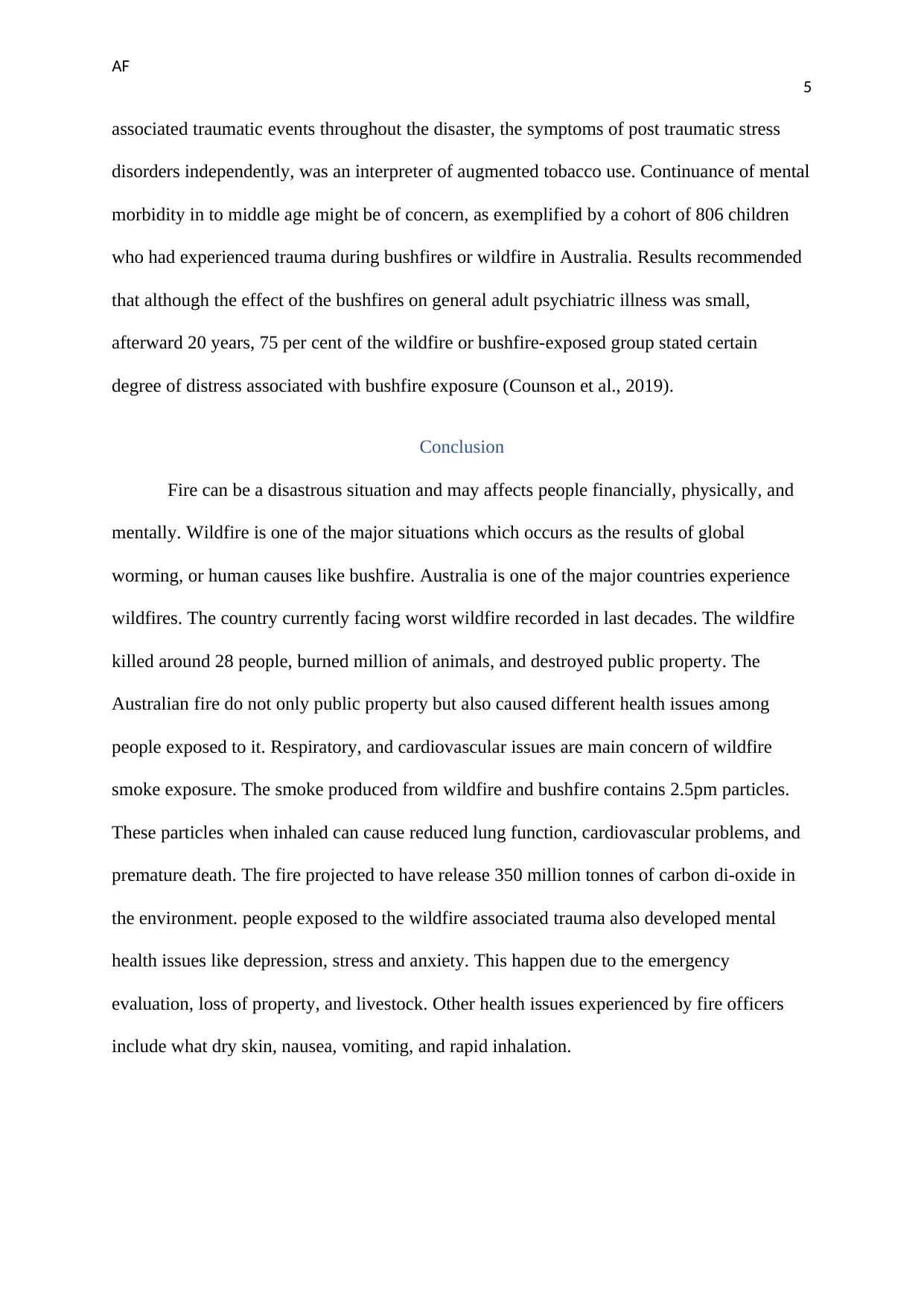
AF
5
associated traumatic events throughout the disaster, the symptoms of post traumatic stress
disorders independently, was an interpreter of augmented tobacco use. Continuance of mental
morbidity in to middle age might be of concern, as exemplified by a cohort of 806 children
who had experienced trauma during bushfires or wildfire in Australia. Results recommended
that although the effect of the bushfires on general adult psychiatric illness was small,
afterward 20 years, 75 per cent of the wildfire or bushfire-exposed group stated certain
degree of distress associated with bushfire exposure (Counson et al., 2019).
Conclusion
Fire can be a disastrous situation and may affects people financially, physically, and
mentally. Wildfire is one of the major situations which occurs as the results of global
worming, or human causes like bushfire. Australia is one of the major countries experience
wildfires. The country currently facing worst wildfire recorded in last decades. The wildfire
killed around 28 people, burned million of animals, and destroyed public property. The
Australian fire do not only public property but also caused different health issues among
people exposed to it. Respiratory, and cardiovascular issues are main concern of wildfire
smoke exposure. The smoke produced from wildfire and bushfire contains 2.5pm particles.
These particles when inhaled can cause reduced lung function, cardiovascular problems, and
premature death. The fire projected to have release 350 million tonnes of carbon di-oxide in
the environment. people exposed to the wildfire associated trauma also developed mental
health issues like depression, stress and anxiety. This happen due to the emergency
evaluation, loss of property, and livestock. Other health issues experienced by fire officers
include what dry skin, nausea, vomiting, and rapid inhalation.
5
associated traumatic events throughout the disaster, the symptoms of post traumatic stress
disorders independently, was an interpreter of augmented tobacco use. Continuance of mental
morbidity in to middle age might be of concern, as exemplified by a cohort of 806 children
who had experienced trauma during bushfires or wildfire in Australia. Results recommended
that although the effect of the bushfires on general adult psychiatric illness was small,
afterward 20 years, 75 per cent of the wildfire or bushfire-exposed group stated certain
degree of distress associated with bushfire exposure (Counson et al., 2019).
Conclusion
Fire can be a disastrous situation and may affects people financially, physically, and
mentally. Wildfire is one of the major situations which occurs as the results of global
worming, or human causes like bushfire. Australia is one of the major countries experience
wildfires. The country currently facing worst wildfire recorded in last decades. The wildfire
killed around 28 people, burned million of animals, and destroyed public property. The
Australian fire do not only public property but also caused different health issues among
people exposed to it. Respiratory, and cardiovascular issues are main concern of wildfire
smoke exposure. The smoke produced from wildfire and bushfire contains 2.5pm particles.
These particles when inhaled can cause reduced lung function, cardiovascular problems, and
premature death. The fire projected to have release 350 million tonnes of carbon di-oxide in
the environment. people exposed to the wildfire associated trauma also developed mental
health issues like depression, stress and anxiety. This happen due to the emergency
evaluation, loss of property, and livestock. Other health issues experienced by fire officers
include what dry skin, nausea, vomiting, and rapid inhalation.
⊘ This is a preview!⊘
Do you want full access?
Subscribe today to unlock all pages.

Trusted by 1+ million students worldwide
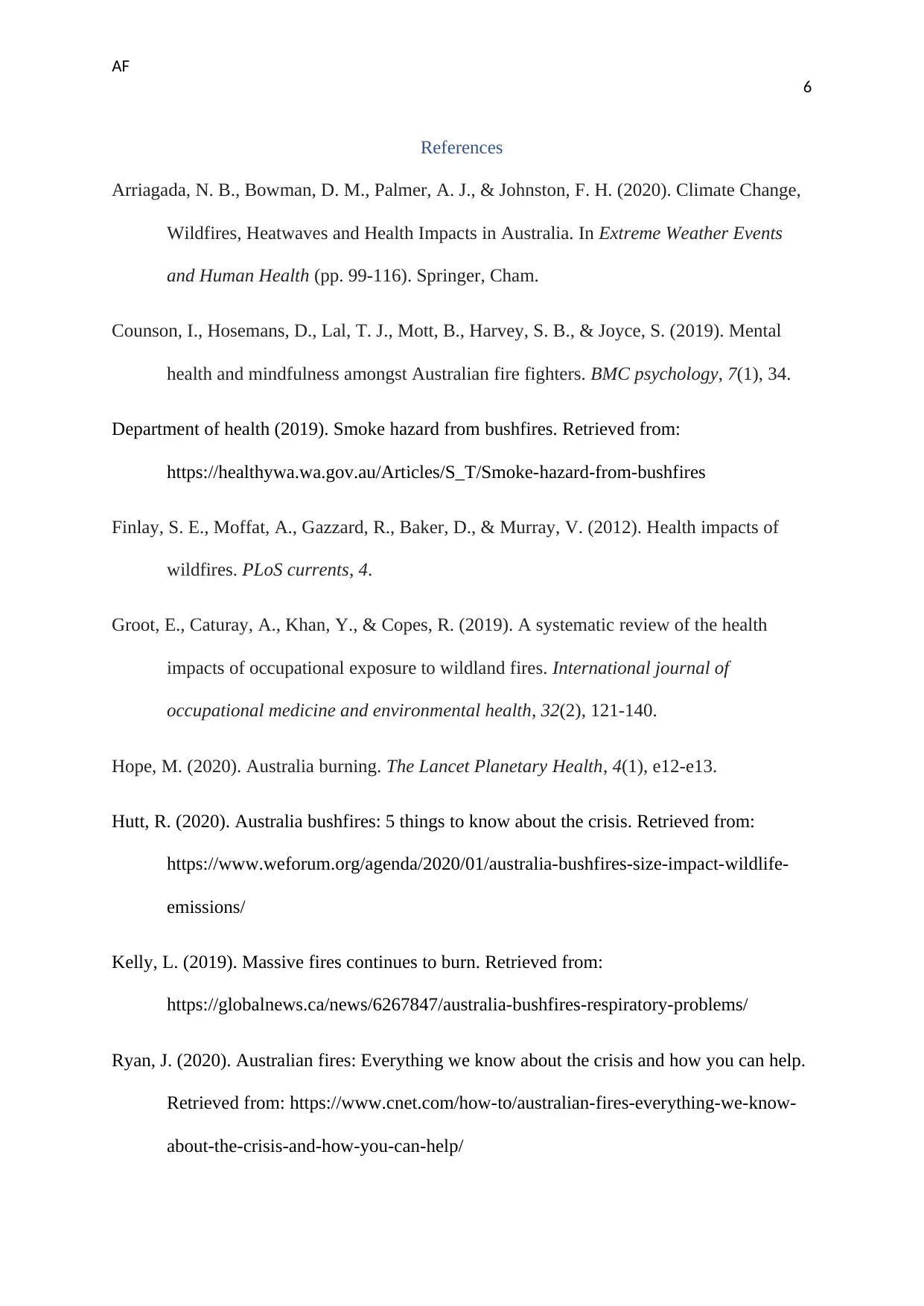
AF
6
References
Arriagada, N. B., Bowman, D. M., Palmer, A. J., & Johnston, F. H. (2020). Climate Change,
Wildfires, Heatwaves and Health Impacts in Australia. In Extreme Weather Events
and Human Health (pp. 99-116). Springer, Cham.
Counson, I., Hosemans, D., Lal, T. J., Mott, B., Harvey, S. B., & Joyce, S. (2019). Mental
health and mindfulness amongst Australian fire fighters. BMC psychology, 7(1), 34.
Department of health (2019). Smoke hazard from bushfires. Retrieved from:
https://healthywa.wa.gov.au/Articles/S_T/Smoke-hazard-from-bushfires
Finlay, S. E., Moffat, A., Gazzard, R., Baker, D., & Murray, V. (2012). Health impacts of
wildfires. PLoS currents, 4.
Groot, E., Caturay, A., Khan, Y., & Copes, R. (2019). A systematic review of the health
impacts of occupational exposure to wildland fires. International journal of
occupational medicine and environmental health, 32(2), 121-140.
Hope, M. (2020). Australia burning. The Lancet Planetary Health, 4(1), e12-e13.
Hutt, R. (2020). Australia bushfires: 5 things to know about the crisis. Retrieved from:
https://www.weforum.org/agenda/2020/01/australia-bushfires-size-impact-wildlife-
emissions/
Kelly, L. (2019). Massive fires continues to burn. Retrieved from:
https://globalnews.ca/news/6267847/australia-bushfires-respiratory-problems/
Ryan, J. (2020). Australian fires: Everything we know about the crisis and how you can help.
Retrieved from: https://www.cnet.com/how-to/australian-fires-everything-we-know-
about-the-crisis-and-how-you-can-help/
6
References
Arriagada, N. B., Bowman, D. M., Palmer, A. J., & Johnston, F. H. (2020). Climate Change,
Wildfires, Heatwaves and Health Impacts in Australia. In Extreme Weather Events
and Human Health (pp. 99-116). Springer, Cham.
Counson, I., Hosemans, D., Lal, T. J., Mott, B., Harvey, S. B., & Joyce, S. (2019). Mental
health and mindfulness amongst Australian fire fighters. BMC psychology, 7(1), 34.
Department of health (2019). Smoke hazard from bushfires. Retrieved from:
https://healthywa.wa.gov.au/Articles/S_T/Smoke-hazard-from-bushfires
Finlay, S. E., Moffat, A., Gazzard, R., Baker, D., & Murray, V. (2012). Health impacts of
wildfires. PLoS currents, 4.
Groot, E., Caturay, A., Khan, Y., & Copes, R. (2019). A systematic review of the health
impacts of occupational exposure to wildland fires. International journal of
occupational medicine and environmental health, 32(2), 121-140.
Hope, M. (2020). Australia burning. The Lancet Planetary Health, 4(1), e12-e13.
Hutt, R. (2020). Australia bushfires: 5 things to know about the crisis. Retrieved from:
https://www.weforum.org/agenda/2020/01/australia-bushfires-size-impact-wildlife-
emissions/
Kelly, L. (2019). Massive fires continues to burn. Retrieved from:
https://globalnews.ca/news/6267847/australia-bushfires-respiratory-problems/
Ryan, J. (2020). Australian fires: Everything we know about the crisis and how you can help.
Retrieved from: https://www.cnet.com/how-to/australian-fires-everything-we-know-
about-the-crisis-and-how-you-can-help/
Paraphrase This Document
Need a fresh take? Get an instant paraphrase of this document with our AI Paraphraser
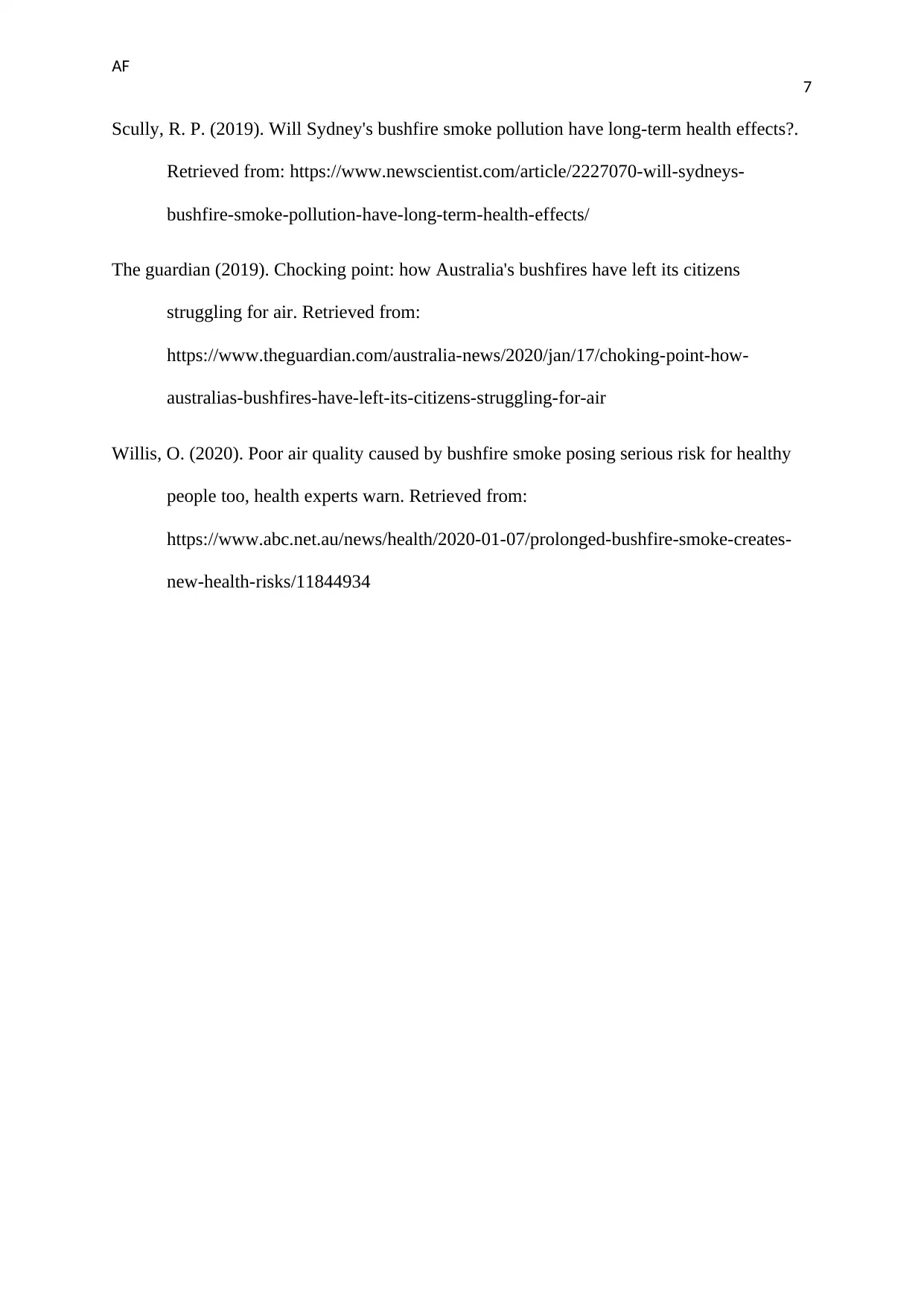
AF
7
Scully, R. P. (2019). Will Sydney's bushfire smoke pollution have long-term health effects?.
Retrieved from: https://www.newscientist.com/article/2227070-will-sydneys-
bushfire-smoke-pollution-have-long-term-health-effects/
The guardian (2019). Chocking point: how Australia's bushfires have left its citizens
struggling for air. Retrieved from:
https://www.theguardian.com/australia-news/2020/jan/17/choking-point-how-
australias-bushfires-have-left-its-citizens-struggling-for-air
Willis, O. (2020). Poor air quality caused by bushfire smoke posing serious risk for healthy
people too, health experts warn. Retrieved from:
https://www.abc.net.au/news/health/2020-01-07/prolonged-bushfire-smoke-creates-
new-health-risks/11844934
7
Scully, R. P. (2019). Will Sydney's bushfire smoke pollution have long-term health effects?.
Retrieved from: https://www.newscientist.com/article/2227070-will-sydneys-
bushfire-smoke-pollution-have-long-term-health-effects/
The guardian (2019). Chocking point: how Australia's bushfires have left its citizens
struggling for air. Retrieved from:
https://www.theguardian.com/australia-news/2020/jan/17/choking-point-how-
australias-bushfires-have-left-its-citizens-struggling-for-air
Willis, O. (2020). Poor air quality caused by bushfire smoke posing serious risk for healthy
people too, health experts warn. Retrieved from:
https://www.abc.net.au/news/health/2020-01-07/prolonged-bushfire-smoke-creates-
new-health-risks/11844934
1 out of 8
Your All-in-One AI-Powered Toolkit for Academic Success.
+13062052269
info@desklib.com
Available 24*7 on WhatsApp / Email
![[object Object]](/_next/static/media/star-bottom.7253800d.svg)
Unlock your academic potential
Copyright © 2020–2025 A2Z Services. All Rights Reserved. Developed and managed by ZUCOL.
